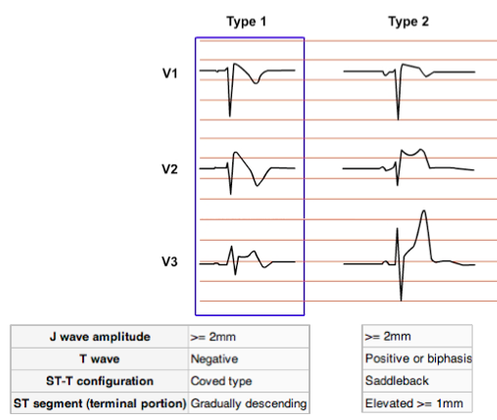Brugada Syndrome
Brugada Syndrome
- Genetically linked, cardiac sodium channelopathy
- High risk for sudden death in young, healthy adults because VTach/VFib
- Mean age of sudden death = 41 ± 15 years
- Higher prevalence in males and Asian descent
- Atrial fibrillation associated in 10-20% cases
ECG findings
- 2 types
- Type 1 – Most specific for Brugada Syndrome
- Highest risk for symptoms of syncope and sudden death

Differential diagnosis
| _ | _ |
|---|---|
| After electrical cardioversion | Friedreich ataxia |
| Arrhythmogenic RV dysplasia | Early repolarization, esp in athletes |
| Atypical right BBB | Hypothermia |
| Acute MI, especiall RV infarct | Pericardial effusion |
| Acute myopericarditis | Pulmonary embolism |
| Compression of RV outflow tract | Left ventricular hypertrophy |
| Disorder of central/auton nerv system | Mediastinal tumor |
| Dissecting aortic aneurysm | Pectus excavatum |
| Duchenne muscular dystrophy |
Treatment
Indications for implantable cardiac defibrillator
Brugada Type 1 PLUS one of following:
- Aborted sudden cardiac death
- Syncope, seizure, or noctural agonal respirations without alternative cause
- Family history of sudden cardiac death (likely from Brugada) AND positive electrophysiology (EPS) study
- A positive EPS study
Otherwise, close followup with cardiologist.
References
- Antzelevitch C, Brugada P, Borggrefe M, Brugada J, Brugada R, Corrado D, Gussak I, LeMarec H, Nademanee K, Perez Riera AR, Shimizu W, Schulze-Bahr E, Tan H, Wilde A. Brugada syndrome: report of the second consensus conference: endorsed by the Heart Rhythm Society and the European Heart Rhythm Association.Circulation. 2005 Feb 8;111(5):659-70. Epub 2005 Jan 17. [PubMed]